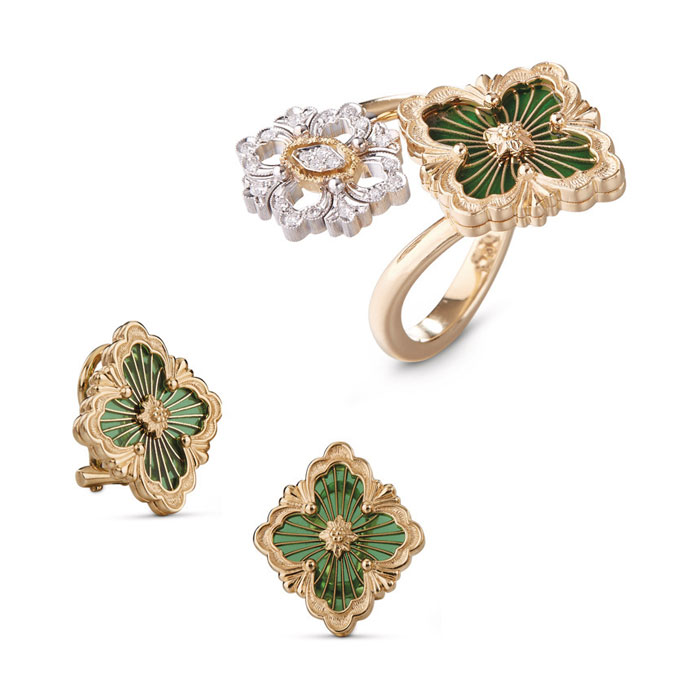Italian heritage jeweller Buccellati sits at the heart of a beautiful triumvirate where art, fashion, and craftsmanship intersect. Designing, and producing by hand, some of the most original works of high jewellery art, its creations offer a unique mix of classical Italian savoir-faire with a distinctive Milanese identity. As one of just a handful of leading jewellers today still managed by its founding family, Buccellati continually pays tribute to the various inspirational touchpoints that led goldsmithing virtuoso Mario Buccellati to start his own business in 1919.
These range from traditional Italian arts and crafts such as Venetian lace and silk making and Etruscan patterns to wildlife and vegetation all throughout the country. Buccellati creations were also very much influenced by the Italian Renaissance period and its progressive interpretations of art, culture, and literature.
But most of all, jewellery by Buccellati forefronts magnificent hand-crafted Italian goldsmithing techniques, some of which had been invented—or reinvented—by the House, and others which had been lovingly preserved and perpetuated by its teams of artisans today. Over the decades, time-honoured techniques like engraving, open-working, enchaining, and more have become an intrinsic part of the Buccellati creative process, synonymous with the jeweller’s signature style. And even within each technique there are stylistic variations, all of which you find infused with Buccellati’s beautiful family history.
Indeed, within hand-engraving alone there are a myriad different styles. Rigato, the one most instantly recognisable by Buccellati fans, yields a delicate sheen reminiscent of the finest silk. It adorns all creations in the iconic Macri collection, such as the delightfully stackable Macri Classica bracelets as well as the Macri cuffs with their sumptuous volumes. Formed by painstakingly engraving multitudes of fine lines all over the gold, this hand-applied technique elevates the simplest of creations onto the realm of high jewellery.

Macri was the brainchild of the company’s second-generation designer, Gianmaria Buccellati. He’d sought to create jewellery that embodied all the iconic features of his family’s jewellery making style—with the added emphasis on engraving. The result was a completely original cuff bracelet design with a beautiful finish reminding us of the most precious textiles, and gemstones set as micro-sculptures.
Named after his youngest daughter Maria Cristina, the collection would go on to inspire later generations of Buccellati designers, such as Andrea Buccellati who gave us the Macri AB and Macri Giglio lines, which were equally iconic but rather more contemporary in spirit

Exquisite hand-craftsmanship continues in the lovely Opera Tulle collection which pays tribute to Italian culture through beautiful symmetry and the floral motif. Observed everywhere that beauty resides, from the San Carlo alle Quattro Fontane in Rome to the Doge Palace in Venice, the designs draw on a combination of different artistic styles including the Renaissance and Venetian Gothic, with a nod to Neo-Medieval. With Opera being deeply connected to Buccellati’s Italian roots, its connection with the Teatro alla Scala in Milan becomes immediately apparent.
Yet in the Opera Tulle collection, Buccellati combines Goldsmithing technique, Tulle craftsmanship and Enameling, with a bright, colourful exuberance it gets from semi-precious stones such as onyx and mother-of-pearl. Tulle collection, also known as honeycombing, is where gold sheets are pierced with a hacksaw to create a network of tiny polygonal holes. But in order to create consistently regular perforations, each cell requires a final round of hand-finishing by a trained artisan with a saw in a complex and labour-intensive process that requires the greatest skill and steady hand of the artisan.

Inspiration for this aesthetic came from the art of Venetian lace making, and Buccellati has made countless masterpieces featuring this technique, such as tiaras, brooch pendants, statement earrings, and more.
Also adding a powerful personality to the pieces is coloured enamel in vibrant hues like blue, green, red, and brown. Enamel, of course, is one of the world’s oldest crafts, dating back to the ancient Greeks and Romans. Here, it sets a dramatic contrast against the filigreed gold structure of Buccellati’s radial tulle pattern, which is another of the company’s signature techniques. Occasionally left completely open-worked, the ethereal lightness of this design is truly breath-taking.
Buccellati forefronts hand-crafted Italian goldsmithing techniques, some of which had been invented—or reinvented—by the House.
Likewise, the Ramage and Rombi collections espouse a similar gossamer effect and Renaissance inspiration, but each with a distinctive core identity. Ramage pieces derive its fluid lines and gentle curves from the simplicity, grace, and majesty of Mother Nature. Vines and foliage, branches and florals spread out in an intricate labyrinth hemmed by textured yellow gold. This fascinating network of botanicals is an extremely challenging task requiring the goldsmith to bore through each 1mm-thick gold plate by hand, before crafting the silhouette of branches and tiny leaves, with tiny diamond blossoms as a final flourish.

Providing an elegant counterpoint to the naturalistic inclinations of Ramage, Rombi pieces on the other hand are stylised to evoke geometric shapes, achieved through a meticulous piercing technique. They also play around with gold tone combinations such as yellow on white, accentuated with diamonds, forming a continuous pattern of rhomboidal elements throughout the piece.

Embodying such heritage-rich artisanal techniques, Buccellati’s gold and silver jewellery is always conceptualised from the heart and then painstakingly made by hand. Surfaces are never ostentatiously shiny, but rather, are meticulously treated with a special effect thanks to the various engraving, open-working, and enchaining techniques. This is the unique savoir-faire of Buccellati, introduced over 100 years ago, but continually honed for the next generation.
Editor-in-chief Desmond Lim
Director and creative producer Vanessa Caitlin
Co-director and director of photography Benjamin Siow
Photographer Zantz Han
Stylist Jasmine Ashvinkumar
Hair and make-up artist Jyue Huey | The Makeup Room
Associate creative producer and video editor Hazirah Rahim
Colourist Chin Wen Khien
1st CA Lim Tian Chye
Grip Yang Yong Qing and Shun Rong
Junior Grip Jia Er and Claralyn Chew
CA Intern Sheila
Production Abundant Productions
Photography assistance Sin Yean and Amos Lee
Creative production assistant Leonard Wong






